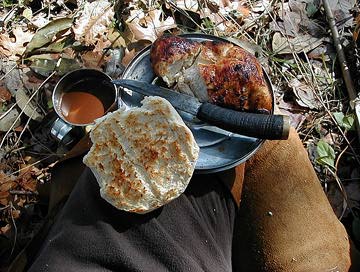

Most of my outdoor activities related to colonial living are done solo, and I've settled on a few foods which, as far as I can discover, are documented to the period of the 1780s, my chosen period of interest. Here are a few camp and trail foods I usually carry. All are chosen for simplicity of preparation, low bulk and weight, and of course, taste. I keep the cooking very simple while on the trail. These simple, lightweight foods, along with some parched corn-maple sugar trail mix for munching during the hike or the hunt, are all I have ever wanted.
All these foods can be prepared with minimal equipment. My kit consists of only a plain 7-cup tin boiler, a tin cup and a horn spoon. Using my belt knife or patch knife and my fingers, I never need anything else for fixing or eating the food.
Meal on a Stick
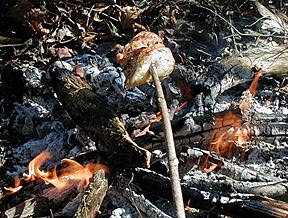 On the first day of any trek I usually cook some fresh meat. I use chicken breasts, pork or venison loin, usually. All these foods are best cooked over a good bed of hot coals, not over flames. After putting it on a stick, just as for toasting marshmallows, I rub in a fair amount of salt, black or cayenne pepper and, usually, an ample grinding of nutmeg, the quintessential spice of the eighteenth century. It takes between thirty and forty-five minutes to roast these meats. Cook them slowly until golden brown on the outside. Make sure the chicken (wash your hands after handling) and pork are cooked thoroughly, leave the venison nicely pink in the middle. If the weather is warm and you plan to cook the meats for the evening meal, you can cheat a little by starting with them frozen. Wrapped in a simple cloth, they will still be cold and safe at dinner time.
On the first day of any trek I usually cook some fresh meat. I use chicken breasts, pork or venison loin, usually. All these foods are best cooked over a good bed of hot coals, not over flames. After putting it on a stick, just as for toasting marshmallows, I rub in a fair amount of salt, black or cayenne pepper and, usually, an ample grinding of nutmeg, the quintessential spice of the eighteenth century. It takes between thirty and forty-five minutes to roast these meats. Cook them slowly until golden brown on the outside. Make sure the chicken (wash your hands after handling) and pork are cooked thoroughly, leave the venison nicely pink in the middle. If the weather is warm and you plan to cook the meats for the evening meal, you can cheat a little by starting with them frozen. Wrapped in a simple cloth, they will still be cold and safe at dinner time.
Plain Venison Jerky
I like to use better cuts for my deer jerky, usually loin or ham. Preparation is very simple, using either a dehydrator or a regular oven. Because I use it in preparing other dishes, I don't season it at all during jerking. Slice the meat about one-quarter inch thick and place it in the dehydrator or in the oven at a very low setting, 150F-200F. It will take 8-12 hours, maybe a bit more, depending on your dehydrator or oven. Let it get very dry, hard and brittle. It can be kept for months in a sealed jar or almost indefinitely if properly wrapped and frozen. To use, simply soak it in water till soft or simmer it in the dish it is to be used in.
Pocket Soup, Portable Soup, Beefe Glue
In the literature of colonial times, mention is made of "pocket soup", "portable soup", "powdered beefe" and "glue broth". This was their equivalent of bullion, and they used it in about the same way. Basically, it is a simple broth made by boiling bones and meat trimmings for several hours until it concentrates into a syrupy consistency, then pouring it in a shallow layer and allowing it to dry till hard (by leaving it in the sun for several days). This was reconstituted by dissolving it in hot water, and served as a sort of instant stock.
Here's my adaptation of the old recipes. This presumes a freshly killed, butchered and de-boned deer.
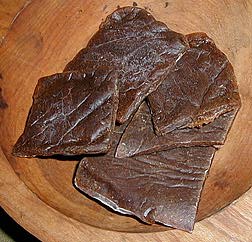 Break all the long bones to allow access to the marrow, add most of the spine and neck bones, whatever tendons or ligaments are available and all the joints on both front and back legs.. Put these into a large stock pot, cover them with water and bring it to a boil. After boiling covered for 8 hours, remove all the meat and bones and let the liquid cool overnight in the refrigerator. In the morning there will a layer of hard white fat and floating solids on top, which you should scoop off completely. Continued to boil, now uncovered, and in about 6 more hours the broth will be very thick, like warm molasses. Be careful not to let it burn. Pour this into a shallow bread pan, and it will make a layer about 3/8 inch thick. When it cools, it will be the consistency of hard jello, very rubbery. Remove it from the pan, cut it into rectangles, place it on waxed paper and dry it in the dehydrator for one day, and it will turn hard. It tastes like a very flavorful meat broth. An old recipe calls for salt, pepper, mace, cloves and brandy to be added during the boiling, which sounds much more highly seasoned than mine. I add only 1 teaspoon of salt.
Break all the long bones to allow access to the marrow, add most of the spine and neck bones, whatever tendons or ligaments are available and all the joints on both front and back legs.. Put these into a large stock pot, cover them with water and bring it to a boil. After boiling covered for 8 hours, remove all the meat and bones and let the liquid cool overnight in the refrigerator. In the morning there will a layer of hard white fat and floating solids on top, which you should scoop off completely. Continued to boil, now uncovered, and in about 6 more hours the broth will be very thick, like warm molasses. Be careful not to let it burn. Pour this into a shallow bread pan, and it will make a layer about 3/8 inch thick. When it cools, it will be the consistency of hard jello, very rubbery. Remove it from the pan, cut it into rectangles, place it on waxed paper and dry it in the dehydrator for one day, and it will turn hard. It tastes like a very flavorful meat broth. An old recipe calls for salt, pepper, mace, cloves and brandy to be added during the boiling, which sounds much more highly seasoned than mine. I add only 1 teaspoon of salt.
It is necessary to have an adequate amount of cartilage and connective tissue to begin with, because the "soup" won't ever get hard without it, that's where the gelatin comes from. If you include all the joints and the spine, it should be alright, but you can add a couple of pounds of pig's feet to make sure. I've never had to do that.
One of the ways the long hunters used this food was to reconstitute it by boiling, then adding a few spoonfuls of parched corn and cooking until this thickened. The result is a sort of meat flavored porridge, very tasty and satisfying.
A square of pocket soup about 2 X 3 inches dissolved in 1 1/2 cup boiling water makes a nice stock. I usually add 1/4 cup toasted yellow stone ground corn meal to the broth and simmer it for about 10 minutes until it thickens nicely. Salt and pepper seasoning make a very tasty meat-flavored "hasty pudding". This is easy to do in camp, and carrying enough cornmeal and pocket soup squares for several day's meals is very little trouble, both being so light and compact. Jerky cut into small pieces and added to the mix makes an even more sustaining meal, and adds little to the weight of my pack.
Drinks
Hot chocolate made with about three cups of water to one disk of Mexican chocolate and about two tablespoons of muscavado sugar really hits the spot at the end of the day and gives you a nice energy boost. Sassafras tea is a tasty and easily made drink, and carrying a few pieces of sassafras root takes almost no room in my kit. A few pieces boiled until the liquid is the color of iced tea, then a tablespoon or so of brown, muscavado or maple sugar added makes a great pick-me-up, and the pieces of root can be used many times. I also carry loose tea, either gunpowder or lapsing souchong, and simply add one teaspoon to each cup of boiling water and let it steep for 3-4 minutes for a good cupper. My coffee is also very simple. I just boil water, add about two teaspoons ground roasted coffee for each cup, remove from the fire and let it steep for ten minutes or so.
Acceptable Additions
 These regular items may be part of my mess on most any trek. In addition, I carry along whatever I want of the foods in season. Apples, peaches, pears and any other fruits are easy to carry, are historically correct, and satisfy both hunger and thirst. Dried fruits, also, serve as tasty munchies on the trail and can be cooked in a little water and sugar for a simple, nourishing and tasty dessert. Sweet potatoes can be simply buried in hot ashes until done, corn on the cob can be either boiled whole, cut up into my pocket soup or roasted on a stick like a weaner. At certain times of the year free foods can be gathered from the land. I have collected and eaten blackberries, may apples, morel and puffball mushrooms, persimmons, black walnut, hazelnuts, hickory nuts, fresh fish and frog legs, rabbit, squirrel, snapping turtle, and many other things to good advantage. I also usually bake up a few small round "penny loaves" of plain white or dark wheat bread to use for the first 2-3 days of a trip or camp. I find that much more simple than trying to make bread in camp by any method I've tried, and bread seems to really round out any meal, whether eaten plain or toasted on a stick.
These regular items may be part of my mess on most any trek. In addition, I carry along whatever I want of the foods in season. Apples, peaches, pears and any other fruits are easy to carry, are historically correct, and satisfy both hunger and thirst. Dried fruits, also, serve as tasty munchies on the trail and can be cooked in a little water and sugar for a simple, nourishing and tasty dessert. Sweet potatoes can be simply buried in hot ashes until done, corn on the cob can be either boiled whole, cut up into my pocket soup or roasted on a stick like a weaner. At certain times of the year free foods can be gathered from the land. I have collected and eaten blackberries, may apples, morel and puffball mushrooms, persimmons, black walnut, hazelnuts, hickory nuts, fresh fish and frog legs, rabbit, squirrel, snapping turtle, and many other things to good advantage. I also usually bake up a few small round "penny loaves" of plain white or dark wheat bread to use for the first 2-3 days of a trip or camp. I find that much more simple than trying to make bread in camp by any method I've tried, and bread seems to really round out any meal, whether eaten plain or toasted on a stick.
A good substitute for ground, parched corn and maple sugar can be made from readily available round corn tortilla chips. I prefer Kroger brand. They are salted only a little, if at all. Simply put a bunch of them in a single layer on a cookie sheet and bake them in the oven at about 250 degrees until golden brown. Don't let them burn. Pulverize them in a food processor, add the maple sugar to your taste as they are being chopped, and you will have a very tasty and handy trail food, much more tender than the real thing. I also like them with brown sugar instead of maple. Be careful not to get them too sweet.
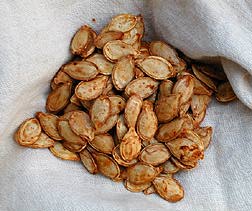
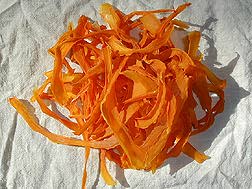 I usually roast some pumpkin seeds every fall for munching on the trail or in camp. Simply separate them from the fibrous pulp of the pumpkin, sprinkle with salt and roast in a single layer on a cookie sheet, or such, at 250F for 25-30 minutes. Don't wash them, the residual pulp helps hold the salt and adds a little something to the taste. The pumpkin flesh can be dried and kept for long periods, then rehydrated in camp and simmered with some sugar, ginger, nutmeg and cinnamon for a tasty stew which tastes like pumpkin pie. Rehydrating the pumpkin takes a few hours, usually, so it's not for the noon break, more for the evening meal at a more permanent camp, when you can let it soak all day. Many references tell of the use of dried pumpkin in colonial times, so this one is on firm historical ground.
I usually roast some pumpkin seeds every fall for munching on the trail or in camp. Simply separate them from the fibrous pulp of the pumpkin, sprinkle with salt and roast in a single layer on a cookie sheet, or such, at 250F for 25-30 minutes. Don't wash them, the residual pulp helps hold the salt and adds a little something to the taste. The pumpkin flesh can be dried and kept for long periods, then rehydrated in camp and simmered with some sugar, ginger, nutmeg and cinnamon for a tasty stew which tastes like pumpkin pie. Rehydrating the pumpkin takes a few hours, usually, so it's not for the noon break, more for the evening meal at a more permanent camp, when you can let it soak all day. Many references tell of the use of dried pumpkin in colonial times, so this one is on firm historical ground.
Copyright © B. E. Spencer 2001-2003 All rights reserved.